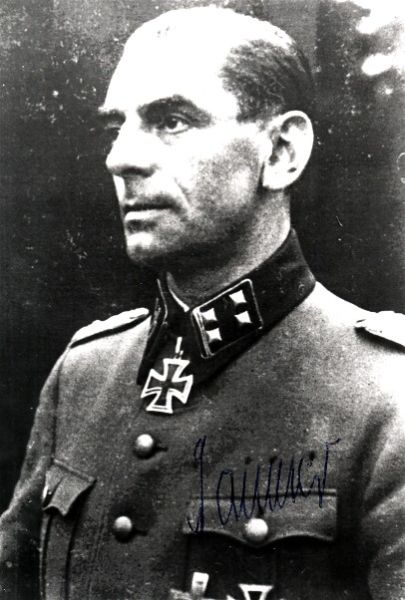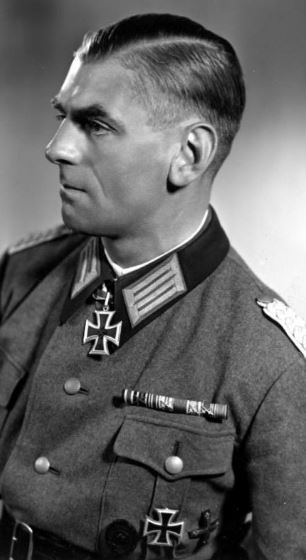Pannier, Rudolf Ernst Max (Waffen SS)
- Date of birth:
- July 10th, 1897 (Gera/Thuringia, German Empire)
- Date of death:
- August 19th, 1978 (Hamburg/Hamburg, Germany)
- Service number:
- SS-Nr.: 465.891 (V) // NSDAP-Nr.:
- Nationality:
- German
Biography
Promotions:
01.05.1917: Ersatz-Rekrut
07.01.1920: Unterwachtmeister der Polizei
1923: Wachtmeister der Polizei
1923: Oberwachtmeister der Polizei
01.04.1924: Polizeileutnant
01.07.1927: Polizei-Oberleutnant
01.04.1932: Polizei-Hauptmann
05.01.1942: Major der Schuzpolizei
01.04.1942: SS-Sturmbannführer der Waffen-SS
1943: Oberstleutnant der Schutzpolizei (mit RDA vom 30.01.1943)
30.01.1943: SS-Obersturmbannführer
1943: Oberst der Schutzpolizei
09.11.1943: SS-Standartenführer der Waffen-SS
Do you have more information about this person? Inform us!
- Period:
- First World War (1914-1918)
- Awarded on:
- 1934
- Period:
- First World War (1914-1918)
- Period:
- First World War (1914-1918)
- Awarded on:
- 1937
- Period:
- First World War (1914-1918)
- Awarded on:
- 1938
- Period:
- Second World War (1939-1945)
- Rank:
- Major der Schützpolizei (Major)
- Awarded on:
- January 8th, 1942
- Period:
- Second World War (1939-1945)
- Rank:
- Major der Schützpolizei (Major)
- Unit:
- Kdr, I. Bataillon, SS-Polizei-Regiment 2
- Awarded on:
- January 20th, 1942
- Period:
- Second World War (1939-1945)
- Rank:
- Major der Schützpolizei (Major)
- Unit:
- Kdr, I. Bataillon, SS-Polizei-Regiment 2
- Awarded on:
- January 28th, 1942
- Period:
- Second World War (1939-1945)
- Rank:
- Major der Schützpolizei (Major)
- Unit:
- Kdr, I. Bataillon, SS-Polizei-Regiment 2
- Awarded on:
- February 5th, 1942
- Period:
- Second World War (1939-1945)
- Rank:
- Major der Schützpolizei (Major)
- Unit:
- Kdr, I. Bataillon, SS-Polizei-Regiment 2
- Awarded on:
- May 10th, 1942
- Period:
- Second World War (1939-1945)
- Rank:
- Major der Schützpolizei (Major)
- Unit:
- Kommandeur, I. Bataillon, Polizei-Schützen-Regiment 2, SS-Polizei-Division, I. Armee-Korps, 18. Armee, Heeresgruppe Nord
- Awarded on:
- May 11th, 1942
“Major Pannier (commander of the I./SS-Pol.Schtz.Rgt. 2) and his Bataillon were subordinated to Brigade Köchlin as it fought to close the breach created by the 2nd Russian Shock Army in the area south of Tschudowo. During this combat he and his Bataillon were encircled in the village of Ljubino Pole (located along the Novgorod-Tschudowo road) on the 23.01.1942.
Although he soon came under attack by Russian forces on all sides, Major Pannier defended his southernmost position (which posed a major threat to the Russian lines of communication from east to west) with a minimal amount of heavy weapons and artillery. During these days of bitter defensive combat the troops only received minimal amounts of ammunition and food via aerial resupply. Major Pannier was on his feet by both day and night, and despite the great effort this demanded he never failed to inspire his troops with a renewed will to resist.
As the situation for the encircled Bataillon continued to deteriorate, several attempts to relieve the unit were launched. However none of these efforts succeeded, and aerial resupply also failed to materialize at times. Thus, on the 04.02.1942, a new relief attempt was launched with the aim of outflanking the enemy positions. However the higher commands were concerned by the failure of previous relief attempts to reach the two villages of both Ljubino Pole and Mosstki (both of which contained encircled German troops). This, combined with the lack of radio communications, resulted in an air-dropped order being delivered to Major Pannier on the 03.02.1942. It instructed him and his unit to break out towards Mosstki on the night of the 03./04.02.1942 and link up with the encircled friendly garrison there.
However Major Pannier was convinced that Mosstki could not be held for any length of time without the simultaneous occupation of of Ljubino Pole. Thus, although the fighting power of his troops was by now badly depleted, he nonetheless decided to go against his orders and hold the village of Ljubino Pole until friendly relief forces arrived. By doing so it would be possible to use the village as a jumping off point for a renewed effort to close the frontline gap, and simultaneously tie down strong enemy forces.
Showing exemplary bravery, Major Pannier inspired his men to achieve their best and was thus able to hold the village of Ljubino Pole for 14 days of bitter combat against Russian attacks that came from all sides. In the most critical hour he made the decision to go against his orders and hold Ljubino Pole until he was relieved.
Thanks to this independent resolve the enemy was able to expand their breach towards the north during this time.
As is clear from the attached note of recognition by the commanding general of the I. Armeekorps, it was the determined stand of the Bataillon that frustrated the enemy’s plan to advance towards Ljuban and enlarge their breach towards the north.
Major Pannier is thus judged to be worthy of being awarded the Knight’s Cross to the Iron Cross on account of the achievements he has exhibited.”
based on a recommendation dated 01.04.1942 and signed by Div. Kdr. Alfred Wünnenberg
- Period:
- Second World War (1939-1945)
- Rank:
- Major der Schützpolizei (Major)
- Unit:
- Kdr, I. Bataillon, SS-Polizei-Regiment 2
- Awarded on:
- August 1st, 1942
- Period:
- Second World War (1939-1945)
- Rank:
- Schützpolizei - Oberstleutnant
- Unit:
- Kdr, Nachschubkommandantur, Russland-Mitte-Brobuisk u. Kdt SS Jäger Rgt 33/9. Armee
- Awarded on:
- January 30th, 1943
- Period:
- Second World War (1939-1945)
- Rank:
- Oberst der Schutzpolizei
- Unit:
- Kdr, SS-Jäger-Regiment 33
- Awarded on:
- December 1st, 1943
- Period:
- Second World War (1939-1945)
- Rank:
- SS-Standartenführer (Colonel)
- Awarded on:
- April 7th, 1944
- Period:
- Second World War (1939-1945)
- Period:
- Second World War (1939-1945)
- Rank:
- Oberst der Schutzpolizei
- Awarded on:
- February 22nd, 1944
- Period:
- Second World War (1939-1945)
- Rank:
- SS-Standartenführer (Colonel)
- Unit:
- Nachschubkommandantur, Rußland-Mitte, Waffen-SS - Bobruisk
- Awarded on:
- April 28th, 1944
Sources
- Photo 1: Willi Schumacher Collection
- - FELLGIEBEL, W.P., Elite of theThird Reich, Helion & Company Limited, Solihull, 2003.
- MOONEY, PETER, Waffen-SS Knights and their Battles, Schiffer Pub Ltd, 2008.
- PATZWALL, K. & SCHERZER, V., Das Deutsche Kreuz 1941-1945, Band II, Verlag Klaus D. Patzwall, Norderstedt, 2001.
- Die Ordensträger der Deutschen Wehrmacht (CD), VMD-Verlag GmbH, Osnabrück, 2002
- Schneider J.W., Their Honor was Loyalty!, R. James Bender Publishing, 1977
- Axis History Biographical Research via Axis History Forum
- das-ritterkreuz.de
- Microfilm Publication A3343. US National Archives

























